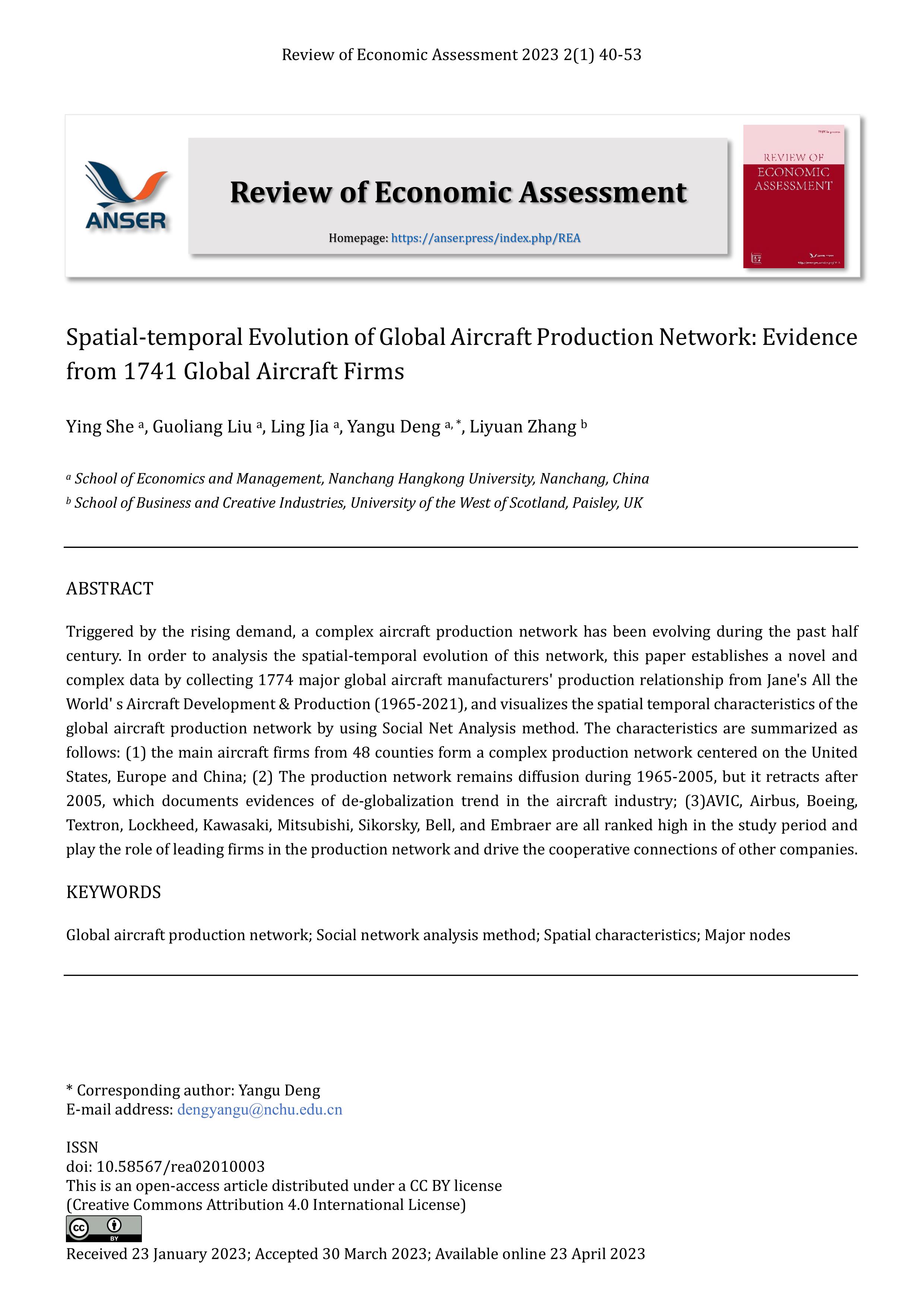Spatial-temporal Evolution of Global Aircraft Production Network: Evidence from 1741 Global Aircraft Firms
DOI:
https://doi.org/10.58567/rea02010003Keywords:
Global aircraft production network; social network analysis method; spatial characteristics; major nodesAbstract
Triggered by the rising demand, a complex aircraft production network has been evolving during the past half century. In order to analysis the spatial-temporal evolution of this network, this paper establishes a novel and complex data by collecting 1774 major global aircraft manufacturers' production relationship from Jane's All the World' s Aircraft Development & Production (1965-2021), and visualizes the spatial temporal characteristics of the global aircraft production network by using Social Net Analysis method. The characteristics are summarized as follows: (1) the main aircraft firms from 48 counties form a complex production network centered on the United States, Europe and China; (2) The production network remains diffusion during 1965-2005, but it retracts after 2005, which documents evidences of de-globalization trend in the aircraft industry; (3)AVIC, Airbus, Boeing, Textron, Lockheed, Kawasaki, Mitsubishi, Sikorsky, Bell, and Embraer are all ranked high in the study period and play the role of leading firms in the production network and drive the cooperative connections of other companies.
References
Ardito, L., Messeni Petruzzelli, A., & Panniello, U., 2016. Unveiling the breakthrough potential of established technologies: An empirical investigation in the aerospace industry. Technology Analysis & Strategic Management, 28(8), 916-934.
Arne Isaksen. Innovation Dynamics of Global Competitive Regional Clusters: The Case of the Norwegian Centres of Expertise[J]. Regional Studies,2009,43(9).
Chu, B., Zhang, H., Jin, F., 2010. Identification and comparison of aircraft industry clusters in China and United States. Chinese Geographical Science, 20(5), 471-480.
Clifton, N., David, R., Ehret, O. & Pickernell, D., 2011. An Analysis of Actual and Potential Clustering Structures, Stakeholder Governance Activities and Cross-locality Linkages in the Welsh Aerospace Industry, European Planning Studies, 19(2): 279-309
Esposito, E., Raffa, L., 2007. Global reorganisation in a high-technology industry: the aircraft industry. International Journal of Globalisation and Small Business, 2(2), 166-184.
Fauri, F., 2021. The Italian State's Active Support for the Aircraftal Industry: The Case of the Caproni Group, 1910–1951. Business History Review, 95(2), 219-247.
Gangi, F., Mustilli, M., Daniele, L. M., & Coscia, M. 2022. The sustainable development of the aerospace industry: Drivers and impact of corporate environmental responsibility. Business Strategy and the Environment, 31(1), 218-235.
Garrette, B., Castañer, X., Dussauge, P, 2009. Horizontal alliances as an alternative to autonomous production: Product expansion mode choice in the worldwide aircraft industry 1945–2000. Strategic Management Journal, 30(8), 885-894.
Huang, L., Zhong, Z., Wu, X., The impact of civil aviation industry agglomeration on high-quality economic development: a threshold regression model test based on provincial panel data. Journal of Beijing University of Aeronautics and Astronautics (Social Science Edition).
Jordi Jofre-Monseny, Raquel Marín-López, Elisabet Viladecans-Marsal. The mechanisms of agglomeration: Evidence from the effect of inter-industry relations on the location of new firms. Journal of Urban Economics,2011,70(2).
Jose Jr L A, Brintrup A, Salonitis K. Analysing the evolution of aerospace ecosystem development. Plos one, 2020, 15(4): e0231985.
Landoni, M., 2019. Convergence of innovation policies in the European aerospace industry (1960–2000). Technological Forecasting and Social Change, 147, 174-184.
Lee, J. J., & Yoon, H., 2015. A comparative study of technological learning and organizational capability development in complex products systems: Distinctive paths of three latecomers in military aircraft industry. Research policy, 44(7), 1296-1313.
Liu J,Qiao P,Ding J, et al. Will the Aviation Industry Have a Bright Future After the Covid-19 Outbreak? Evidence From Chinese Airport Shipping Sector. Journal of Risk and Financial Management, 2020, 13: 1-2.
McGuire, S., 1999. Sectoral innovation patterns and the rise of new competitors: the case of civil aerospace in Asia. Industry and Innovation, 6(2), 153-170
McGuire, S., and Islam, N., 2015. Indigenous Technological Capabilities, Emerging Market Firms and the Aerospace Industry. Technology Analysis & Strategic Management 27 (7): 739–758.
Niosi, J., Zhegu, M., 2005. Aerospace clusters: local or global knowledge spillovers? Industry & Innovation, 12(1), 5-29.
OECD. 2014. The Space Economy at a Glance 2014. Paris: OECD Publishing.
Park, Y., Lee, S. 2012. Patent Analysis for Promoting Technology Transfer in Multi-Technology Industries: the Korean Aerospace Industry Case. The Journal of Technology Transfer 37 (3): 355–374.
Pritchard, D. J., 2002. The global decentralization of commercial aircraft production: Implications for US based manufacturing activity (Doctoral dissertation, State University of New York at Buffalo).
Romero, J. M., 2011. Centripetal forces in aerospace clusters in Mexico. Innovation and Development, 1(2): 303-318.
Rozhkov, M., Ivanov, D., Blackhurst, J., & Nair, A. 2022. Adapting supply chain operations in anticipation of and during the COVID-19 pandemic. Omega, 110, 102635.
Steenhuis, H. J., Kiefer, D., 2016. Early stage cluster development: a manufacturers-led approach in the aircraft industry. Competitiveness Review, 26(1), 41-65.
Turkina E, Van Assche A, Kali R. Structure and evolution of global cluster networks: evidence from the aerospace industry. Journal of economic geography, 2016, 16(6): 1211-1234.
Zhao, W., Li, F. Research on the Impact of the Internet on Civil Aviation Strategy.Technical Economy and Management Research, 2021, (2): 101-105.
Zheng, X., Liu, Q., Zhao, Z. Technical barriers to trade with China and national economic security. International Economic Review, 2023 (01): 131-151+7-8.
Zhu, Y., Song, X., Yan, W., et. al Research on Shaanxi Aviation Industry Upgrading Strategy Based on TRIZ Theoryg. Research on Science and Technology Management, 2020, 40(3): 155-162.

Downloads
Published
How to Cite
Issue
Section
License
Copyright (c) 2023 Ying She, Guoliang Liu, Ling Jia, Yangu Deng, Liyuan Zhang

This work is licensed under a Creative Commons Attribution 4.0 International License.
